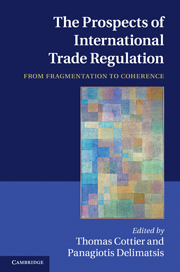Book contents
- Frontmatter
- Contents
- List of figures
- List of tables
- Contributors
- Preface and acknowledgements
- Table of cases
- List of abbreviations
- Introduction: fragmentation and coherence in international trade regulation: analysis and conceptual foundations
- PART I Constitutional issues in international trade regulation
- PART II Reforming specific areas of trade regulation
- PART III ‘Trade and…’ linkages
- 8 A call for a WTO ministerial decision on trade and human rights
- 9 The protection and promotion of cultural diversity in a digital networked environment: mapping possible advances towards coherence
- 10 Development and stability in the nexus between trade and finance
- 11 The regulatory framework of international investment: the challenge of fragmentation in a changing world economy
- 12 Low-income countries and commodity price volatility
- Index
- References
9 - The protection and promotion of cultural diversity in a digital networked environment: mapping possible advances towards coherence
from PART III - ‘Trade and…’ linkages
Published online by Cambridge University Press: 26 April 2011
- Frontmatter
- Contents
- List of figures
- List of tables
- Contributors
- Preface and acknowledgements
- Table of cases
- List of abbreviations
- Introduction: fragmentation and coherence in international trade regulation: analysis and conceptual foundations
- PART I Constitutional issues in international trade regulation
- PART II Reforming specific areas of trade regulation
- PART III ‘Trade and…’ linkages
- 8 A call for a WTO ministerial decision on trade and human rights
- 9 The protection and promotion of cultural diversity in a digital networked environment: mapping possible advances towards coherence
- 10 Development and stability in the nexus between trade and finance
- 11 The regulatory framework of international investment: the challenge of fragmentation in a changing world economy
- 12 Low-income countries and commodity price volatility
- Index
- References
Summary
KEY MESSAGES
∙ Neither the WTO nor UNESCO currently offers appropriate solutions to the trade and culture predicament that would allow for efficient protection and promotion of cultural diversity.
∙ The trade and culture discourse is over-politicised and owing to the related path dependencies, a number of feasible solutions presently appear blocked.
∙ The digital networked environment has profoundly changed the ways cultural content is created, distributed, accessed and consumed, and may thus offer good reasons to reassess and readjust the present models of governance.
∙ Access to information appears to be the most appropriate focus of the discussions with a view to protecting and promoting cultural diversity in the new digital media setting, both in local and global contexts.
∙ This new focal point also demands broadening and interconnecting the policy discussions, which should go beyond the narrow scope of audiovisual media services, but cautiously take account of the developments at the network and applications levels, as well as in other domains, most notably protection of intellectual property rights.
∙ There are various ways in which the WTO can be made more conducive to cultural policy considerations and these include improved and updated services classifications; enhanced legal certainty with regard to digitally transferred goods and services; and incorporation of rules on subsidies for services and on competition.
Introduction
Cultural diversity as a concept and as a distinct public policy objective has substantially gained in significance in the past decade and its role is likely to be augmented in the years to come.
- Type
- Chapter
- Information
- The Prospects of International Trade RegulationFrom Fragmentation to Coherence, pp. 359 - 393Publisher: Cambridge University PressPrint publication year: 2011

